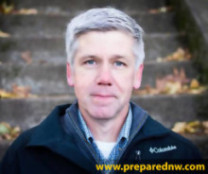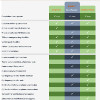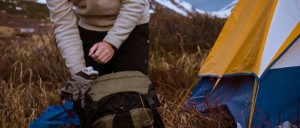
Apr 7, 2018

Being prepared can reduce fear, anxiety, and losses that accompany disasters.
Preparing yourself and your family with at least a 72 hour kit and an emergency plan will reduce anxiety and panic should you find yourself in a disaster situation.
Many emergencies don’t allow time for people to assemble even the most basic items, which is why preparedness planning is so important. In addition to first aid and emergency kits, our site offers emergency supplies for virtually any disaster.
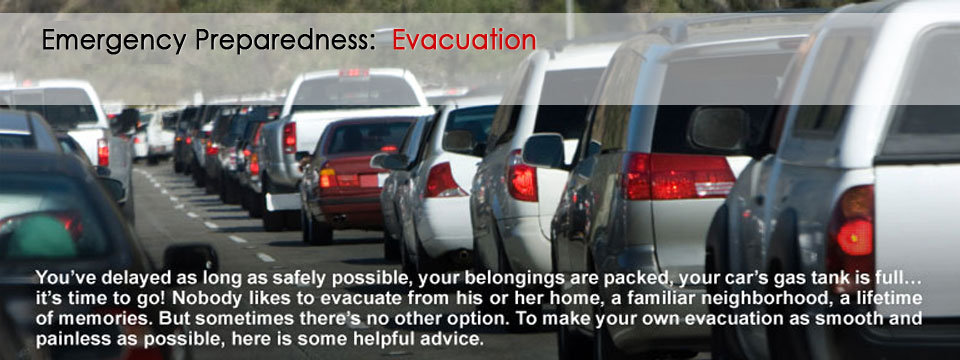
Dec 13, 2014
During most natural disasters like flooding or ice and snowstorms, the best advice is to stay home and shelter in place. What I’ll be discussing in this article are those times when you need to leave. These times would be due to a house fire, a house structurally unfit to live in; damage from an earthquake, flooding, landslide, wildfire or a mandatory official evacuation.
If you are leaving the house due to an emergency, there are three main factors to consider: Information, Navigation and Transportation.
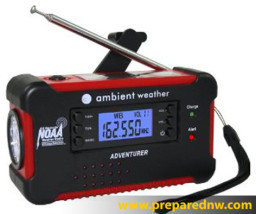
First is information. This is your top priority, as this will help you avoid citywide or regional hazards that might interfere with your evacuation. Travel information might include the condition of roadways, recommended escape routes, locations of emergency shelters, incoming weather events or the availability of gasoline. There are a number of methods for receiving information relating to emergencies and travel conditions. The most common is the Internet, television and radio. If the power is out, your choices will be limited to battery or hand-cranked radios or a weather alert radio. During power outages check landline telephones as they tend to be battery backed-up and you may be able to contact friends or family living outside the disaster area. If you are away from home, your car radio can be used for information gathering. Other communication tools to use while away from home are the FRS (Family Radio Service) or Walkie-Talkie, CB (Citizen Band) radio like those used by truckers, and GMRS (General Mobile Radio Service) included on most advanced two-way radios. FRS and GMRS have the frequency range to receive NOAA (National Oceanic and Atmospheric Administration) weather and disaster emergency information.
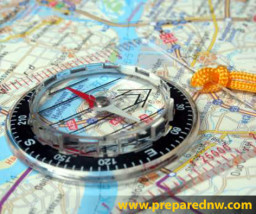 Second is navigation. GPS (Global Positioning System) is great when it works but what about a volcanic eruption, global war, etc. Physical maps such as those made of paper that don’t depend on technology, a road atlas (DeLorme or Rand McNally) and a magnetic compass are the best alternative. Navigation allows you to efficiently travel from point A to point B as well as making detours without getting lost. Plan your escape route from home using information that you know about road conditions, blocked roads and traffic flows. Identify possible alternative routes in the event the primary route doesn’t work. Plan to violate conventional traffic rules in times of emergencies, if required.
Second is navigation. GPS (Global Positioning System) is great when it works but what about a volcanic eruption, global war, etc. Physical maps such as those made of paper that don’t depend on technology, a road atlas (DeLorme or Rand McNally) and a magnetic compass are the best alternative. Navigation allows you to efficiently travel from point A to point B as well as making detours without getting lost. Plan your escape route from home using information that you know about road conditions, blocked roads and traffic flows. Identify possible alternative routes in the event the primary route doesn’t work. Plan to violate conventional traffic rules in times of emergencies, if required.
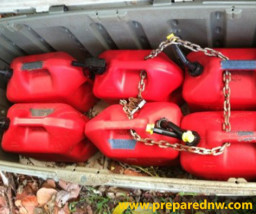 Lastly is your mode of transportation. Make sure you have enough fuel stored to travel at least 500 miles. Before leaving your home, fully fuel your vehicle from these gas cans and bring a spare, full can, to take with you. Pack your vehicle with supplies including things you might need for roadside emergencies. To successfully evacuate, have a reliable vehicle that’s always regularly maintained and in ready condition. Fuel efficiency will trump a heavy vehicle due to the fact that fuel might be hard to find. Many other types of transportation are available like motorcycles, boats and bikes for local moves but nothing beats the car. The car allows you to move a minimum of 500 pounds of supplies great distances in relative safety and comfort while dry and warm. Your supplies are mostly secure and you have a place to shelter should you get stopped or stranded in route.
Lastly is your mode of transportation. Make sure you have enough fuel stored to travel at least 500 miles. Before leaving your home, fully fuel your vehicle from these gas cans and bring a spare, full can, to take with you. Pack your vehicle with supplies including things you might need for roadside emergencies. To successfully evacuate, have a reliable vehicle that’s always regularly maintained and in ready condition. Fuel efficiency will trump a heavy vehicle due to the fact that fuel might be hard to find. Many other types of transportation are available like motorcycles, boats and bikes for local moves but nothing beats the car. The car allows you to move a minimum of 500 pounds of supplies great distances in relative safety and comfort while dry and warm. Your supplies are mostly secure and you have a place to shelter should you get stopped or stranded in route.
Having a plan and preparing in advance can turn an unbearable situation into a comfortable inconvenience.
Share your personal experiences and/or questions about Emergency Preparedness and Transportation in the comments below.
 Prepared Northwest offers families in Oregon and Washington consultations and customized emergency preparedness plans that fit their needs and budget. Contact us today for a free initial consultation. 503-757-7572 or email preparednw@gmail.com.
Prepared Northwest offers families in Oregon and Washington consultations and customized emergency preparedness plans that fit their needs and budget. Contact us today for a free initial consultation. 503-757-7572 or email preparednw@gmail.com.
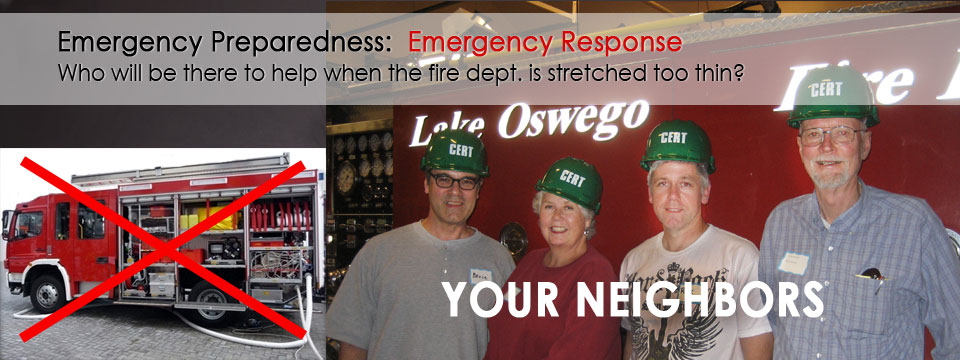
Oct 20, 2014
What can the citizens of Lake Oswego expect from professional emergency responders such as the L.O. police and the L.O. Fire Department should a magnitude 8 or 9 earthquake* hit Oregon and Washington? The Fire Department has 12 full-time firefighters on duty in any 24-hour period plus a Duty Chief who can handle the emergency response load during any normal day; that’s 13 firemen to help a city of 37,000 individuals. When larger scale problems occur there are mutual aid agreements with fire departments in surrounding cities to join forces and help out. So what happens when we have our magnitude 8 or 9 earthquake and 10% (a conservative estimate) of the population needs help in one form or another?
Many people don’t realize this but our fire department will be stretched much too thin to help most of our citizens. Their priorities are to make sure all fire department personnel are safe, that their fire apparatus is in good working order and their fire station is safe and secure. The crews will then pull their apparatus out of the bays and check for radio communications. After that the Duty Chief determines which emergencies have the highest priority and dispatches the crews. If the radios are not operational, they would start patrolling their local area, stopping only for major life safety issues.
Who can you expect to get help from if the Fire Department is unable to come to your aid? It will be your neighbors. Neighbors will be responsible for protecting and preserving life and property in the earliest stages of a mass casualty event. They will also be responsible for rescuing and delivering care to victims near the incident site. Keep in mind that if you are not injured then you will be expected to help others.
The most important point to be made here is that YOU will be the first responder. Now is the time to take that CPR class, that CERT (Community Emergency Response Team) training, that EMT (Emergency Medical Technician) class, etc. so you can help yourself, your own family and then neighbors when help is most needed. Historically, cities whose citizens and neighborhoods had established organized emergency preparedness plans and worked together fared significantly better than those that did not.
Lake Oswego Neighborhood Associations have developed a city-wide, city sponsored, Emergency Preparedness committee PREP LO (Prepare Lake Oswego). This committee’s purpose is to provide free information to neighborhoods about how to plan and prepare themselves and/or their neighborhoods for a variety of possible emergency situations. Several Lake Oswego neighborhoods including Palisades and Waluga have already begun successful pilot programs. To learn more about how you and your neighbors can get organized contact the LOFD at 503-635-0275. You can also set up a neighborhood gathering and invite the Assistant Fire Chief to speak about emergency preparedness.
(*) Magnitude 8-9 subduction zone earthquakes have occurred in the Pacific NW over 43 times in the past 10,000 years.
Having a plan and preparing in advance can turn an unbearable situation into a comfortable inconvenience.
Do you have a question about Emergency Preparedness?
Please comment below or contact us at 503-757-7572 or email preparednw@gmail.com.
 Prepared Northwest offers families in Oregon and Washington consultations and customized emergency preparedness plans that fit their needs and budget. Contact us today for a free initial consultation.
Prepared Northwest offers families in Oregon and Washington consultations and customized emergency preparedness plans that fit their needs and budget. Contact us today for a free initial consultation.
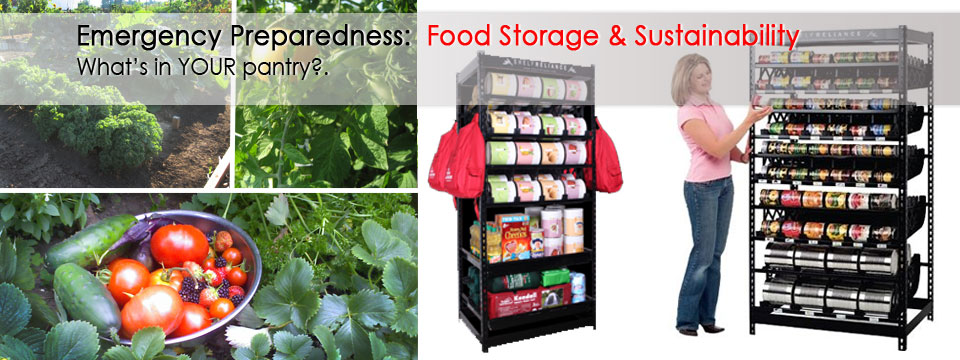
Sep 9, 2014
Eating is one of those conveniences that we Americans take for granted. Very little of our paycheck goes to food purchases compared to other parts of the world. Many Americans have embraced a just-in-time food buying concept for their food shopping habits. How many times do you think about what’s for dinner while driving home from work? What would happen to your eating habits should a natural disaster (like an earthquake) hit your area?
Most folks keep a week to 10 days of food in their home and this includes canned goods, frozen and ready to eat packaged items. The thought is that they will run down to the grocery store and stock up on Spam, water and canned foods after the disaster hits. The problem with this mindset is that everyone else will be doing the same thing. What if there’s no electricity to use that credit card machine?
The smartest thing you can do is stock up ahead of time but with what and how much? It depends on many things like: What duration of time are you planning for? How many people in your family? What are your family’s dietary restrictions? What time of year is it? What’s your method of cooking?
I’ve seen multiple numbers relating to how much food a person consumes each year, roughly 2000 pounds. (This includes fresh, frozen, canned and processed) So to make the numbers easy to work with, let’s assume 150 pounds of food is needed per person per month. If your goal is to have a ready to go 30 day supply of food for a family of 4 that would be 600 pounds of food. Ready to go foods consist of those that are high in calories, require little time to prepare, tastes good and are easy. So which foods do you eat first? That first week, eat all the perishable foods like refrigerator and freezer items; they’re going to be the first to spoil. Next, you should have a stockpile of staples like: freeze-dried or dehydrated foods, whole grains, beans and rice and a large assortment of canned foods. You can use your BBQ to heat up water and hydrate the beans and rice, add the dried vegetables and pour a couple of pantry cans into the pot. Depending on the pot size, this could feed the family for a couple of days.
Other foods to have on hand would be MRE’s. Meals Ready to Eat is a staple for the US military and they are easy to acquire. Check places like Craigslist.com and survival stores in your area for availability. The cost for a case of 12 will usually run between $60-80 and they include the water-activated heaters for a warm meal. I brought up the time of the year to show the differences between storing foods during the summer and the winter. First, fridge and freezer foods will keep longer during the winter but you will also need more fuel to heat water during this time. Summer offers the benefits of fresh fruits and vegetables to supplement your food needs but those fridge and frozen items will spoil much faster.
The most important item to consider when stockpiling food is: will your family eat it? Take the time to plan out your 30 day list of foods and make sure its part of your normal eating habits. This will keep your stored foods rotated and fresh should the need arise.









